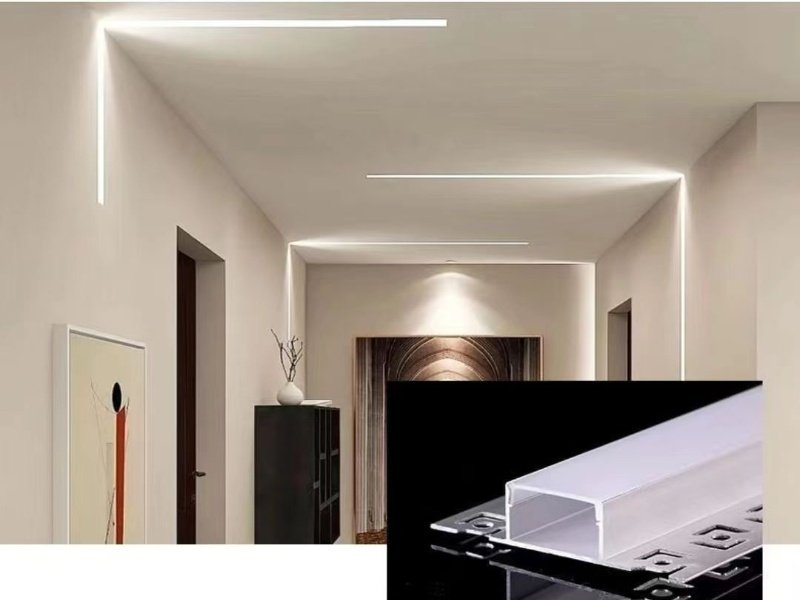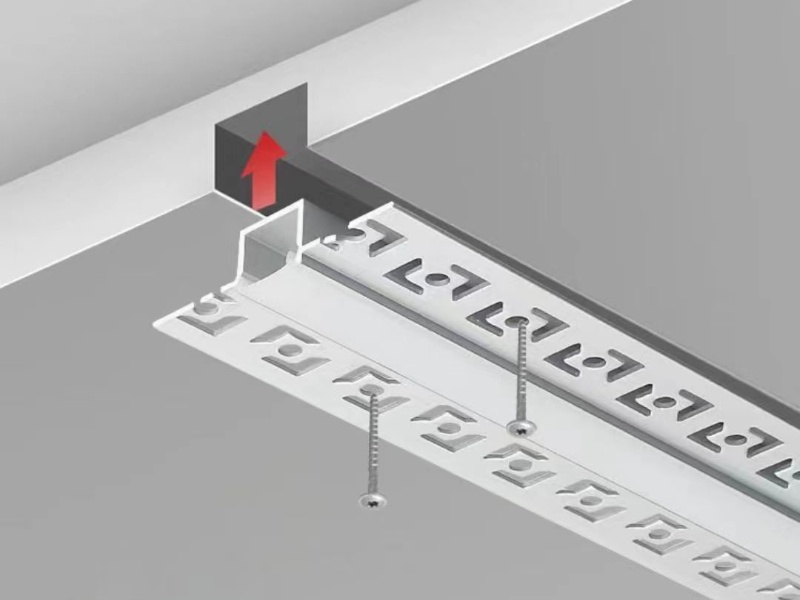1. How do I choose a drywall LED channel for my ceiling lighting?
Selecting the right gypsum wall drywall LED channel for your ceiling lighting involves considerations ranging from design preferences to following aspects practical installation.
1.1 . Consider Design and Style:
When choosing a plaster Trimless recessed drywall LED profile for ceiling lighting, consider the design and style that aligns with your overall interior aesthetic. Plaster-in LED Aluminum Channels come in various shapes, sizes, and finishes, so opt for one that complements your decor seamlessly.
1.2. Brightness and Color Temperature:
Determine the desired brightness level and color temperature for the room. Plaster LED strip channels offer a range of options in terms of lumens and color temperatures. For spaces like living rooms or kitchens, you might prefer brighter, cooler lighting, while warmer tones may be suitable for bedrooms.
1.3. CRI (Color Rendering Index):
Assess the CRI of the LED channel track. A higher CRI ensures better color accuracy, making your room appear vibrant and true to color. This is particularly important in areas where accurate color representation matters, such as art studios or dining rooms.
1.4. Dimming Capability:
Check whether the LED channel is dimmable. Dimming functionality provides flexibility in adjusting the light intensity according to different occasions and moods. Ensure compatibility with your existing dimmer switches or consider investing in smart dimming solutions for added convenience.
1.5. Ease of Installation:
Evaluate the ease of installation, especially if you plan to undertake the installation yourself. Some LED channels come with user-friendly mounting systems or kits that simplify the installation process. Clear installation instructions and online tutorials can be valuable resources.
1.6. Material and Durability:
Examine the material and build quality of the LED channel. Opt for channels made from durable materials that can withstand the test of time. Aluminum profiles are commonly used for their lightweight yet sturdy characteristics.

2.How can I install my plaster LED profile on the ceiling?
2.1. Prepare the Ceiling:
Ensure that the ceiling is clean and free from dust. Any imperfections or irregularities should be addressed before installation. Smooth surfaces contribute to a seamless and professional-looking result.

2.2. Measure and Mark:
Accurately measure and mark the placement of the LED strip profile on the ceiling. Consider the overall lighting design and ensure that the channels are evenly spaced for uniform illumination.
2.3. Cutting the Drywall:
Use appropriate tools to cut the drywall to accommodate the LED channel. Precision is crucial to achieving a neat and integrated look. Be mindful of any electrical wiring or structural elements in the ceiling.
2.4. Secure the LED Channel:
Follow the manufacturer’s guidelines for securing the LED channel in place. Some channels come with mounting brackets, while others may require screws or adhesive. Ensure a secure and stable installation to prevent sagging over time.
2.5. Connect Wiring:
If your LED channel requires wiring, carefully connect it according to the provided instructions. If you are uncertain about electrical work, it’s advisable to seek professional assistance to ensure safety and compliance.
2.6. Install Diffusers or Covers:
Attach any diffusers or covers included with the LED channel. These accessories not only enhance the aesthetics but also serve functional purposes by diffusing light and reducing glare.
2.7. Test the Lighting:
Before completing the installation, test the lighting to ensure that everything is functioning correctly. Make any necessary adjustments to the positioning or wiring if needed.
2.9. Final Finishing:
Once satisfied with the installation, perform any final finishing touches. This may include patching and painting the surrounding drywall for a seamless integration of the LED channels into the ceiling.
Choosing and installing a drywall LED channel for ceiling lighting involves a thoughtful blend of design considerations and practical aspects. By carefully assessing your preferences, understanding the technical specifications, and following proper installation procedures, you can create a well-lit and visually appealing space that complements your overall interior design.













Leave A Comment
You must be logged in to post a comment.